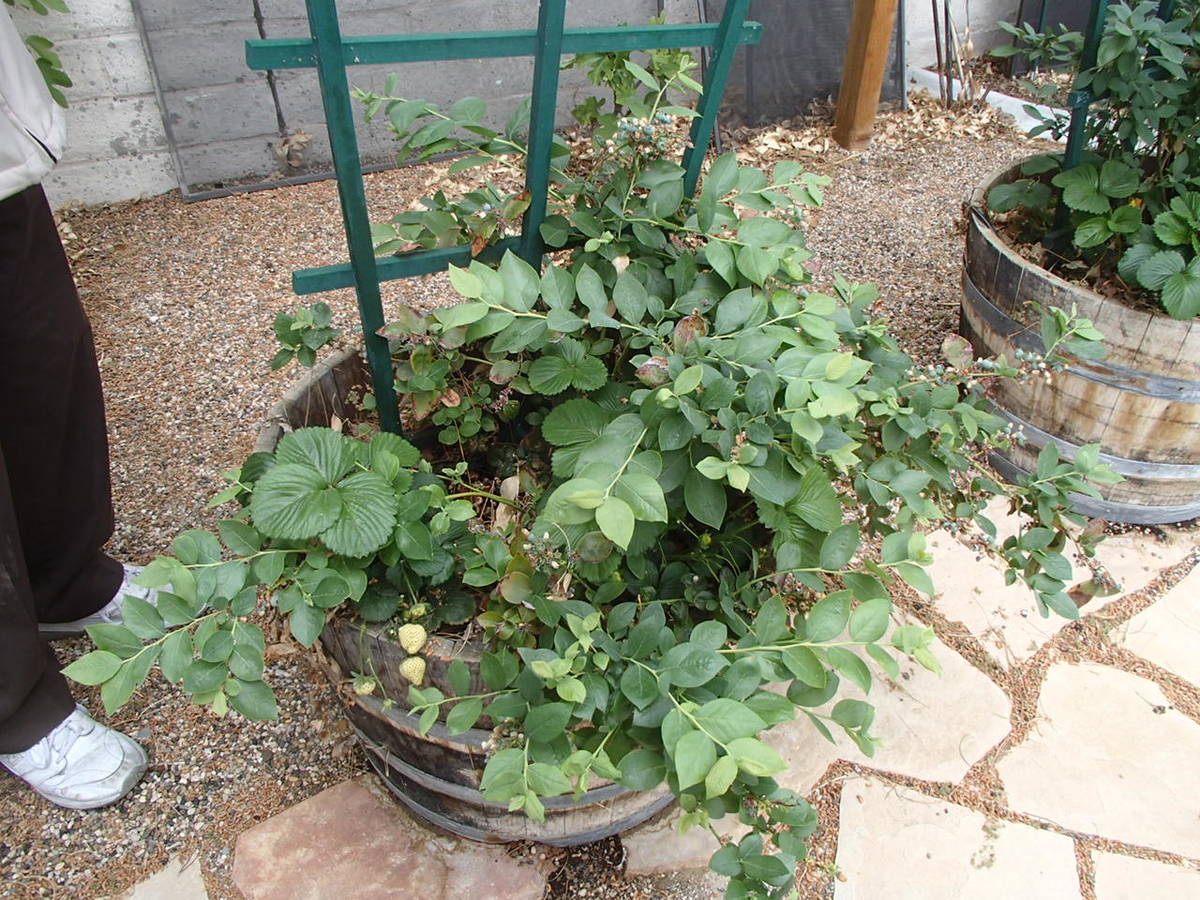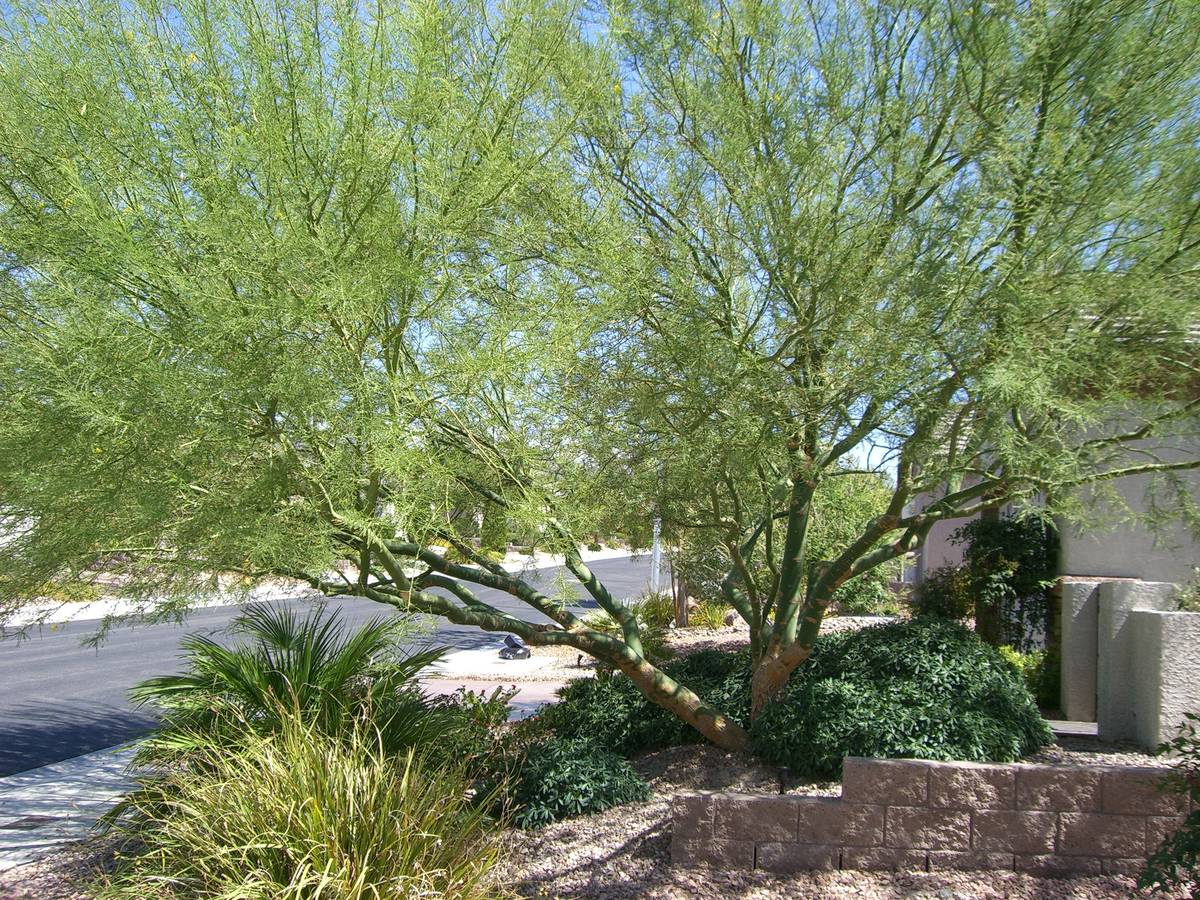Las Vegas landscape design determines watering
The mature size of trees, shrubs and other plants, their numbers and their origins determine the amount of water required to support your landscape. Once a landscape design is finished, the amount of water it needs is fixed. You won’t be able to change the amount it needs, by much, without removing plants or changing them.
Massive trees like Aleppo pine, poplars, cottonwoods and lacebark elm require deep irrigations and more water. Water should be applied to wet the soil 3 feet deep or more for large trees. Medium-sized trees like Chitalpa, ash and African sumac should be watered 24 inches deep. Small trees like desert willow, Texas mountain laurel and California redbud should be watered 18 inches deep.
Their depth of rooting affects their health and resistance to heat damage. The same goes for shrubs of a similar size.
As the number of plants used in the landscape increases, more water is needed. Maybe not in the beginning when they are small but when they get bigger.
Also, the amount of water they need is not necessarily additive because planting them close together can affect each other’s water use. In other words, two ash trees planted close together affect the sunlight, wind, irrigation and other things that impact their individual water use.
The type of trees — whether they are mesic or xeric — also affects how they respond to applied water. Mesic trees and plants originate from wet climates (think oleander, palms, iris). These plants don’t do as well when water is in short supply. They cannot grow and leaf out quickly after a drought as xeric trees and shrubs can (think acacia, Texas mountain laurel, penstemon). Xeric plants have coping mechanisms that handle water shortages (like shedding leaves or slowing growth).
Xeric plants can be coaxed into using less water and then respond quickly with strong growth and increased density when water is available. Many xeric plants are sensitive to heavy daily waterings, particularly during high temperatures.
But xeric plants offer the best opportunities for water savings. Most water savings with xeric plants happen because of less frequent watering rather than the amount of water applied.
You can have the best irrigation system and plants in the world, but if you apply the water wrongly, it still results in water waste.
Q: We have a single zone (one valve) irrigation system in our yard with about 50 various plants. Plants include two mature olive trees, citrus, a dozen roses, flowerpots and various bushes and cactuses. We water the cactuses by hand. We automatically water once a day, deeply, for about 20 minutes. Some friends of ours water three times a day, and my son waters twice a day with no problems. Please comment.
A: The flowerpot plants determine how often a one-valve irrigation system is turned on — its frequency. The plants in the flowerpots control when water is turned on, or they suffer and we see it. The remaining plants adjust to whatever daily watering schedule they are given.
You are satisfied with this watering schedule. Everything looks good. How about your plants in the long run?
Watering in the desert is the lifeblood of a landscape. Plant roots grow best where there is the ideal mixture of water and air. A balance must exist between both but not too much of either one if the plant is to be healthy and survive.
Watering too often or poor drainage, and the roots drown. Skipping a day when it’s hot, the plants suffer from drought.
Watering daily encourages the roots of plants to grow near the soil surface. That’s where this ideal mix happens. Watering daily may be fine for small plants with shallow roots but not for deep-rooted trees like your olives or citrus.
The larger plants prefer a lot of water applied at once — slowly or held in a reservoir around the tree — then no more applied water until half of that water is used. This irrigation strategy encourages deeper tree rooting, more tolerance to hot weather and better resistance to strong winds.
So ideally for the plants, more irrigation valves are needed to encourage the deeper rooting of trees and shrubs. But if you are happy with how the plants look, satisfied with your water bill, want to use only one valve and don’t care about tree health and longevity, then watering them once, twice or three times daily will work.
If you haven’t done it, cover the soil with a layer of wood chip mulch to control weeds and conserve water. As wood chips rot, the roots of large trees have a bigger area to find places to grow. The olive trees can tolerate rock mulch, but wood chips for the citrus and roses work best in the long term.
Q: Ten bottle trees planted last year thrived but then suddenly lost all their leaves at the very top during the wind. The trees are watered with drip twice a day, three times a week for the past month. The rest of the trees and the leaves look healthy. My landscaper suggested that the wind stripped the leaves. I have doubts since my neighbors’ bottle trees of the same age look perfectly healthy.
A: I like to follow the KISS principles and get these possibilities out of the way before I jump to unusual conclusions like strong wind. I suspect this problem may be associated with their watering and not necessarily the wind.
Trees lose their leaves at the top either from lack of water or watering too much. Both cause leaves to loosen from the branches and the wind just blows them away. By the way, a quick Google tells me bottle trees get 60 feet tall with irrigation — big trees as they get older.
Irrigations applied two or three times per week in late April and early May would be about right for established trees provided they are given enough and it is applied to a large area under the canopy. This means the amount of water should not be measured in minutes but in gallons. The number of emitters and their spacing is important information to tell me because these are responsible for the amount they apply and for distributing the water under the tree canopy.
Trees planted from 15-gallon containers should get at least 8 to 10 gallons of water when first irrigated and probably double that the second or third year as the roots explore the surrounding soil and the tree gets larger and more established. Two or three drip emitters placed 12 inches from the trunk are all that is necessary the first year after planting.
But by the second or third year after planting, the trees need more drip emitters farther from the trunk. Doubling the number of emitters and placing them farther away from the trunk accomplishes this without changing the number of minutes.
With a thin piece of 4-foot-long rebar, make sure the water is applied deep enough by pushing it into the soil in several places immediately after an irrigation. The soil around bottle trees when young should be wet to about 24 inches deep immediately after an irrigation and 36 inches deep when they get bigger.
Q: What can I use for a privacy hedge that will be less than 10 feet tall?
A: Green Cloud or Gray Cloud varieties of Texas ranger, aka Texas sage, will grow to that height with irrigation, keep their leaves (if it’s a warm winter) and become denser as they are hedge pruned. Plant them 3 to 4 feet apart when growing them for a privacy hedge, mix compost into their backfill when planting, and water the heck out of them the first couple of days.
Texas ranger is native to the Chihuahuan desert of the U.S. and Mexico. After it is established, it will not require frequent irrigations unless you want it to grow rapidly. But it will require deep irrigations if you want its roots to grow deeply, become more tolerant of hot weather and drought.
These medium-sized shrubs handle either rock or wood chip mulch. Lightly fertilize them in the spring with a second application of high nitrogen fertilizer — think ammonium sulfate, 21-0-0 — in mid- to late November, and watering through the winter helps keep them evergreen through the coldest winter.
Bob Morris is a horticulture expert and professor emeritus of the University of Nevada, Las Vegas. Visit his blog at xtremehorticulture.blogspot.com. Send questions to Extremehort@aol.com.



















